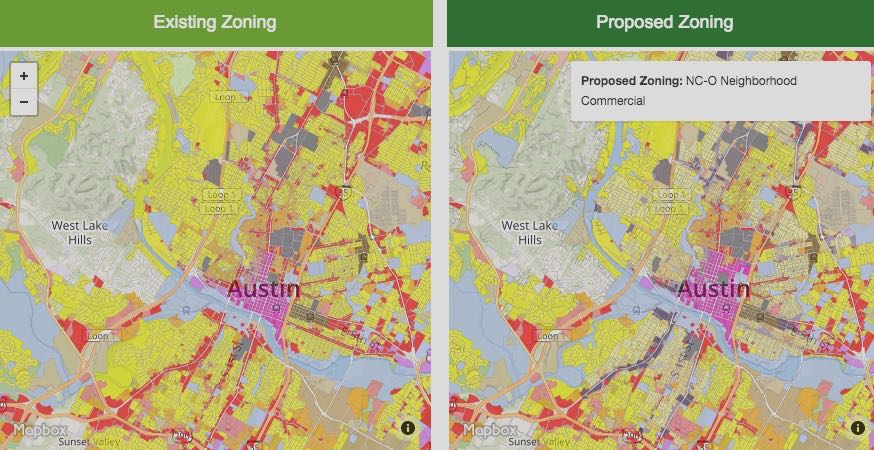Well, it finally happened. After years of work and anticipation, the CodeNEXT maps were released to the public earlier this week.
What’s CodeNEXT again?
CodeNEXT is the city’s effort to rewrite its land development code, which is basically a rule book for the city, explaining what can be built where. CodeNEXT will determine how Austin looks 10, 15, and even 50 years from now. And it will affect everything from affordability, to transportation, to the environment. In other words, it’s a really big deal.
Wait, wasn’t a CodeNEXT draft released several months ago? What’s the difference between the code text and the maps?
As you might remember, the new draft of our land development code was released in January. This gets a little wonky, but the code text itself is simply the framework. It lays out all of the different zoning possibilities in a city (like residential, commercial, or industrial). The maps actually apply the code to individual plots of land and neighborhoods. In essence, this is where CodeNEXT stops being so theoretical and becomes real for everyone living in Austin.
That’s why Austin Mayor Steve Adler declared Tuesday (the day the maps were released) as “Austin Everybody Chill Out Day.” In a Facebook post, he reminded everyone that the maps released this week are only a starting point and that, “To get them to a good place is going to take everyone working together in good faith. We can all win if we take a deep breath, relax, roll up our sleeves, and get to work.”
Neighborhoods vs. Density
One of the main reasons why Adler asked everyone to relax after the draft maps were released is because of the ongoing (and often contentious) debate between preserving neighborhood character and increasing density and housing supply in the city.
Many neighborhood associations have expressed fear that CodeNEXT will bring too much additional development into their largely residential neighborhoods, changing them forever.
At the same time, those pushing for a more compact, connected, and dense Austin have expressed both hopefulness that CodeNEXT can help Austin address its significant housing supply shortage and fear that it won’t go far enough.
This has created a debate within Austin over whether or not the city can preserve neighborhoods while affordably accommodating all of the new people who are moving here everyday.
Mayor Adler believes that both can be achieved. “…We’re going to focus on supply along the corridors and in the centers, we’re going to work to preserve the character of the neighborhoods,” Adler said in a press conference on Tuesday. “There are going to be some transition areas that we’re going to need to work our way through…”
The CodeNEXT staff agree with this premise as well and have estimated that these changes can add nearly 144,000 new housing units to Austin over the next 10 years, which fits in with City Council’s own goals.
So now that the maps are out, what are people saying?
Not everyone completely agrees with Adler’s belief that we can make CodeNEXT quite a win, win, win situation. Since the maps were only released on Tuesday, many organizations are taking a bit more time before they come out with official opinions and ideas, but here is what they’re saying so far…
AURA, a local nonprofit organization that focuses on land use, affordability, and mobility said in a Facebook post that, “The CodeNEXT maps released yesterday reveal near-fatal flaws. It’s not a time to ‘chill out,’ but to take action and demand changes that meaningfully address Austin’s worsening affordability, mobility, environmental, displacement, and segregation problems.” They also published a blog post listing more specific concerns about the new CodeNEXT maps, which you can read here.
Evolve Austin, a nonprofit organization that champions the Imagine Austin plan (and is essentially a coalition of several local organizations, including Austin Habitat for Humanity, Bike Austin, Ecology Action, and Environment Texas), said in their own Facebook post that, “there is a lot of work to do to improve CodeNEXT and the zoning maps introduced this week. We look forward to working with you to push for the changes needed to build a more compact, connected and affordable Austin.”
Why are we doing this?
The one thing that most people can agree on is that it’s time to update Austin’s land development code. Austin’s current land development code is old, outdated, and confusing. This slows down the pace of development and adds a lot of additional costs to new housing projects, at a time when the city is desperate for more affordable housing options.
How can I get involved?
In case you haven’t already figured it out, CodeNEXT is important, which means it’s important for everyone to get involved… but how?
First, you can check out the draft land development code here and look through the proposed maps here. With the map tool, you’re able to compare and contrast our current zoning maps with the new ones, as well as comment on the entire new map.
The city will also be hosting a series of open houses in each City Council district, so that you can get a better idea of how CodeNEXT could impact your specific neighborhood. A full list of upcoming open houses is available here.
And last, but not least, a coalition of local organizations, including the Save Our Springs Alliance, Sierra Club, Workers Defense Project, and more are hosting “Code – What’s Next?” on Sunday, April 30th from 2pm to 5pm in the cafeteria of Southwest Key Programs in east Austin. The event is an opportunity to hear from community leaders whose neighborhoods have been torn apart by Austin’s development policies and ravaged by flooding. There will also be a discussion on how CodeNEXT could affect some of these issues, as well as how it could impact the local environment and the people living within it.




